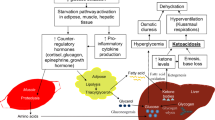Abstract
Diabetic ketoacidosis is the major source of morbidity and mortality in patients with Type I diabetes mellitus. One population-based study noted that approximately 25% of newly diagnosed patients present with diabetic ketoacidosis.1 Most of those hospitalized with diabetes ketoacidosis, however, are those with poor control of their pre-existing diabetes. Cerebral edema has been found to be present in only 1% of children with diabetic ketoacidosis, but accounts for 20% of all diabetes-related deaths.2 Although the mortality rate has fallen dramatically over the course of the last century, the underlying mechanisms involved with the development of cerebral edema are still not clear. Several studies have shown specific risk factors to be associated with cerebral edema, but as of yet no reduction in the recent incidence of cerebral edema has been demonstrated. A discussion of these risk factors and a suggested protocol for treating diabetic ketoacidosis are included in this review.
Similar content being viewed by others
References
Pikney JH, Bingley PJ, Sawtell PA, Dunger DB, Gale EA. Presentation and progress of childhood diabetes millitus: a prospective population-based study.Diabetologia 1994; 37: 70–74.
Glaser N, Barnett P, McCaslin Iet al. Risk factors for cerebral edema in children with diabetic ketoacidosis.N Engl J Med 2001; 344: 264–269.
Bello FA, Sotos JF. Cerebral oedema in diabetic ketoacidosis in children.Lancet 1990; 336–364.
Rosenbloom A. Intracranial crisis during treatment of diabetic ketoacidosis.Diabetes Care 1990; 13: 22–33.
Glasgow AM. Devestating cerebral edema in diabetic ketoacidosis before therapy.Diabetes Care 1991; 14: 77–78.
Couch RM, Acott PD, Wong GW. Early onset of fatal cerebral edema in diabetes ketoacidosis.Diabetes Care 1991: 14 : 78–79.
Harris GD, Fiordalisi I, Harris WL, Mosovich IX, Finberg L. Minimizing the risk of brain herniation during treatment of diabetic ketoacidemia: a retrospective and prospective study.J Pediatr 1990; 117: 22–31. [Erratum,J Pediatr 1991; 118 :166-167.
Harris GD, Fiordalisi I. Physiologic management of diabetic ketoacidemia. A 5 year prospective pediatric experience in 231 episodes.Arch Pediatr Adolesc Med 1994; 148: 1046–1052.
Silver SM, Clark EC, Schrodeder BM, Sterna RH. Pathogenesis of cerebral edema after treatment of diabetic ketoacidosis.Kidney Int 1997; 51: 1237–1244. [Erratum,Kidney Int 1997; 51 :1662.]
Dillon ES, Riggs HE, Dyer WW. Cerebral lesions in uncomplicated fatal diabetic acidosis.Am J Med Sci 1936; 192: 360–365.
Mahoney CP, Vlcek BW, DelAguila M. Risk factors for developing brain herniation during diabetic ketoacidosis.Pediatr Neurol 1999; 21: 721–727.
Kaufman FR, Halvorson M. The treatment and prevention of diabetic ketoacidosis in children and adolescents with type I diabetes mellitus.Pediatr Ann 1999; 28: 576–582.
Author information
Authors and Affiliations
Rights and permissions
About this article
Cite this article
Neal Ramesh, P. Diabetic ketoacidosis in the pediatric patient. Indian J Pediatr 69, 75–77 (2002). https://doi.org/10.1007/BF02723781
Issue Date:
DOI: https://doi.org/10.1007/BF02723781




